2025 Garden To-Do’s Recap 1#
Here are the gardening references we shared over the past month. We’re big fans of Colorado State University extension, so you’ll see us referencing them all the time. However, we also have some written articles just for you under our blog! There will be more gardening references for the year, so stay tuned!
Relative Houseplant Care/Rescuing House Plants:
Listen…shhhhh…if you listen closely, you can hear that neglected plant in the corner crying for help. You did not mean to cause harm. Whether you left for your holiday travels in a rush and failed to give your plants some extra TLC before you left, or you do not know the plant’s needs, the stress is equally killing you. You are at the point of not knowing what to do to make your plants happy again. No worries! We got you on our blog!
Starting Seeds Indoors:
We know it seems early, but the sooner you start your seeds the better. For tomato and pepper plants it’s recommended you start them outside once soil temperatures reach 50 degrees at night. This however doesn’t work well for Colorado’s short growing season. To get the most produce out of your vegetables we recommend starting seeds indoors now and in February! All you need is a seed-starting soil mix and a grow kit!
Seed Starting Troubles:
Have you been waiting for your seeds to pop up and still nothing? No matter what you do, your seedlings perish. There are multiple factors as to why your seeds may not be sprouting. Seed age, crusting soil, and temperature fluctuation are just a few. In the article below by CSU Extension, scientists review why your seeds may not thrive as they should. Fear not, solutions are provided to fix issues and to get those seeds growing! Happy gardening!
Winter Watering:
If air temperature is above 40 degrees it’s time to winter water! Read more about winter watering rules below!
https://www.csu.org/blog/winter-watering-tips
Do’s & Dont’s of Transplanting:
Want to get bang for your buck when starting transplants? Learn the dos and don’ts of growing transplants by copying and pasting the link below! And if you need containers we wanted to remind you we have a free drop off/pick up bin behind the store in our parking lot-perfect for starting seeds or other transplants (once they’re clean that is)!
Garden Planning:
Now’s a great time to start garden planning for spring! Remember to consider space when mapping your beds and companion plants! The links below will lead to more information about early garden planning and companion plants!
General Info:
Companion Plants:
General Onion Care:
Intimidated by growing and planting onions? How about storage, before and after planting and growing these flavorful bulbs? And what the heck does daylight have to do with all of it?
Among the hundreds of questions involving onions you may have, we’ve contacted the experts for their advice. Learn the essentials for onion care from Dixondale Farms!
Growing Potatoes at Home:
Want to try growing potatoes this season in your home garden? We have a link for you! We recommend reading Colorado State University article on the subject!
https://extension.colostate.edu/topic-areas/yard-garden/potatoes-in-the-home-garden-7-617
Spring Bulb Care:
Intimidated by growing spring bulbs? Don’t be with Colorado State Extensions help! Learn how to keep beautiful spring bulbs, corms, and roots alive by reading the article below or in our story/highlights. The article provides everything from choosing a perfect planting spot to planting depth for certain favorites Happy gardening!
https://extension.colostate.edu/topic-areas/yard-garden/spring-planted-bulbs-corms-and-roots-7-411
Rick’s Tree Planting Guide:
We know many of you are familiar with our Tree Planting Guide, so here it is again! This guide is perfect for those interested in buying a tree or about to plant a new one. We also sell mulch, root stimulators, and mycorrhizae for tree planting! Happy gardening!
https://www.ricksgarden.com/wp-content/uploads/2021/04/Ricks-Tree-Shrub-Planting-Guide.pdf

Getting Home & Garden Ready For Sale
Despite mortgage interest rates continuing to climb in the past several months, in this military base-saturated city, we continue to have a thriving real estate market. If you are prepping a house for sale, know that it does not have to be scary! Historically most house sales occur in the spring, so the later winter months are the perfect time to begin thinking about how to improve your curb appeal and get a “to-do” list fleshed out in time for your spring sale. Sprucing up your yard is especially important.
The first thing you should do is take your blinders off. You probably have lived at your house for some time. Pretend you are pulling up to the house for the first time or walk by your house like you are new to the neighborhood. Take notes. Like an artist, you will come back to this step multiple times, building a masterpiece!
- Do you have a couple of ways your eye can “travel” through the landscape? If not, how can you add interest in multiple areas of your yard?
- What are the immediate eye sores? Clean those up or remove them immediately.
- What is the highlight of your home and yard? How can you further accent it?
- What trees or shrubs need to be trimmed?
- Are there holes in the landscape? Can a tree, shrub, ornamental grasses, several perennials, or a boulder fill in the gaps?
The second thing that is helpful to do right now is a general yard cleanup. Even if your yard is ho-hum, an easy way to elevate the place is to do some general yard maintenance.
- Clean pathways/ sidewalks by sweeping dirt/ debris or pulling weeds
- Rake leaves off your lawn. Leaves can be mulched into your lawn also, by running a lawn mower over them.
- Remove any weeds. Pulling is preferred especially now, when they are most likely dead. Feel free to put a natural pre-emergent down, like corn gluten. This will prevent weed seeds from germinating in the spring.
- Pruning should be done in the spring, but take note of which trees or shrubs should be addressed before your sale.
- Consider if outdoor statement containers should be purchased, so you can plant vibrant flowers ahead of putting your home on the market.
- Add a fresh layer of mulch or gravel to refresh any landscaping areas. Do not forget to put a weed pre-emergent down under the mulch and on top of the new mulch, to discourage weed growth. There is nothing more aggravating than completing a clean landscaping job to have weeds pop up in the spring. You can also consider laying down weed barrier fabric under the mulch.
- It should also be mentioned that you should remove any yard art that is specific to your “aesthetic.” You want potential buyers to imagine their own lives when doing a home walkthrough. Pack the garden gnomes away for when you move into your new place!
Next, you will want to address outdoor lighting. If you plan on selling in the spring, you will be hitting the market before it is light in the evenings. You will want to ensure that you make your house feel welcoming as people come to showings after getting off of work.
- Highlight your entrance. This is the most important area to highlight. If you are concerned about light pollution, make sure the light casts downward, instead of out or upward. If you are further interested in reducing light pollution at your home, check out this resource on what light fixtures are best: Click here!
- Other areas to consider lighting include pathways, the address number on your house, and any architecture or plants you want to illuminate.
Finally, consider your plant life. You will not do any planting until spring, but this is a wonderful time to find plants that will fit your needs. In the first step, you identified if your eye traveled through the house/garden lay out, if there were any highlights, and if there were holes in the landscape. As you choose plants to fit these roles, consider the following:
- How much water does it require? Will you be able to ensure it gets the water it needs until you sell? Will potential buyers be turned off by the amount of water that you use? Consider more xeric or water-wise options, if this is the case.
- How much maintenance will it require? For example, many younger buyers are no longer interested in lawns, due to the regular, watering, fertilization, aeration, and mowing that a lawn requires.
- If you have deer or rabbits in the neighborhood, consider choosing species that are resistant to their munching, so all of your plants look good for your closing!
- Resources that are helpful when selecting native plants or water-wise plants are detailed below:
- Plant Select is a brand of plants that we sell. They have an excellent variety of plants and detailed descriptions of each plant. They specialize in plants that are, “…unique, smart, and sustainable plants inspired by the Rocky Mountain region.” Check them out here: Click here!
- High Country Gardens is another gem of information. They “…offer a diverse and ever-expanding selection of plants for the unique challenges of Western gardens.” Use their perennial filter to drill down to find those difficult-to-find plants that are deer-resistant, in partial shade, water-wise, and good for your zone. Check them out here: Click here!
- Finally, a local resource. Please check out the water-wise demonstration gardens that the Colorado Springs Utilities have. They have two different locations listed below. All of the plants are labeled, which is helpful when you find a plant you have fallen in love with! It is helpful to go visit through the four seasons, so you see how foliage and plants change throughout the year. Check them out here: Click here!
There you have it! Good luck with getting your property ready for sale!

Tool Care Guide
Fall is here! This is a bittersweet moment for me. Harvest has hit its finale, and I am beginning to accumulate a stack of books that will keep me growing while my garden begins to take a snooze. Before I cozy up on the couch, and have a cup of tea- I always take care of my end-of-season garden tool maintenance. Garden tools should have regular TLC, especially after use, but in reality, this may not happen. I will detail daily care at the end of this article for your convenience.
End-of-Season Garden Tool Maintenance:
Deep Clean and Oil Pruners:
This is imperative to reduce disease and rust on your snippers, prolonging their use.
- Pruners should be taken apart and deep cleaned at least once each season.
- Unscrew any nuts/ bolts that hold the pruners together.
- Wash all parts separately in soapy water.
- Soak all parts in vinegar, then rinse with water.
- Rub with steel wool to remove any rust, then rinse and dry.
- Soak in diluted bleach water to sanitize, then rinse and dry.
- Buff with linseed oil and reassemble.
Sharpening:
Both pruners and Hori knives, as well as long-handled tools (hoes and shovels), need to be sharpened every season. Keeping pruners sharp helps produce clean cuts on plants, reducing the entry of any disease. Other tools benefit from a sharpening, making your life much easier. Digging a hole to plant with a dull shovel is no fun!
- Anything you are going to sharpen should be cleaned first. Long-handled tools may not need the vinegar/ bleach/ oil treatment unless there are concerns about rust.
- Push the sharpening file in the same direction across the blade and follow the original blade angle. Do not rub the file or stone back and forth, this does not sharpen but dulls the blade further.
- Smooth these newly filed edges with a sharpening stone.
- We recommend wearing eye protection and gloves when sharpening to protect against metal slivers.
Care for Wood Handles:
With long-handled tools, it is important to take care of wood handles. Utilize durable tape (think athletic tape or other heavy-duty tape) for minor cracks. Anything that is more compromised should be replaced immediately to prevent injury.
- Wipe down the handles with a damp cloth.
- Inspect for cracks or any weak spots between the handle and the tool head. Address with durable tape or replace the wooden handle if damaged.
- If needed, lightly sand the handle to smooth splinters, and rub linseed oil to condition.
Daily Garden Tool Care (when you have time!):
Generalized care:
- Rinse any digging tools, then use a wire brush or something similar to get rid of any stuck dirt or debris.
- Scrub snippers down with a brush and soapy water.
- If any tools were used with diseased plants or infected soil, make sure you disinfect them before any other use. Soak the infected tools in a diluted solution of 2 cups of bleach mixed with 1 gallon of water. Then rinse in plain water, and follow with a generous wipe of rubbing alcohol.
- Before storing tools, rub them dry with a rag.
- To help prevent rust on digging tools, mix a bucket of sand with plant-based oil, like linseed oil (avoid any petroleum oils, as this reduces plant vitality). The sand should be damp with oil, but not wet. Plunge any blades, tines, or teeth into the sand a few times for a quick clean, or do this following regular maintenance once the tools have been wiped dry.
- Store your tools in a dry and well-ventilated place. Small hand tools can be stored directly in a dry bucket of sand or gravel, and larger tools should be hung so as not to dull their blades in a mad scramble.
Removing Sap:
- Wipe blades with a rag dipped in mineral spirits or turpentine.
- Submerge and clean the blades in soapy water. Rinse and then wipe with linseed oil.
Preventing and Removing Rust:
- Soak any tools showing signs of rust in a 50/50 mixture of vinegar and water overnight.
- Scrub the affected areas with steel wool.
- First, wash in soapy water, and then rinse.
- Rub dry and then buff with linseed or a mineral oil.
All tool maintenance requires is a little elbow grease and time. Sometimes we neglect our tools throughout the season, but I can tell you the reward of pulling out a clean, sharp, and shiny tool in the spring never ceases to make me smile. Happy fall, everyone!
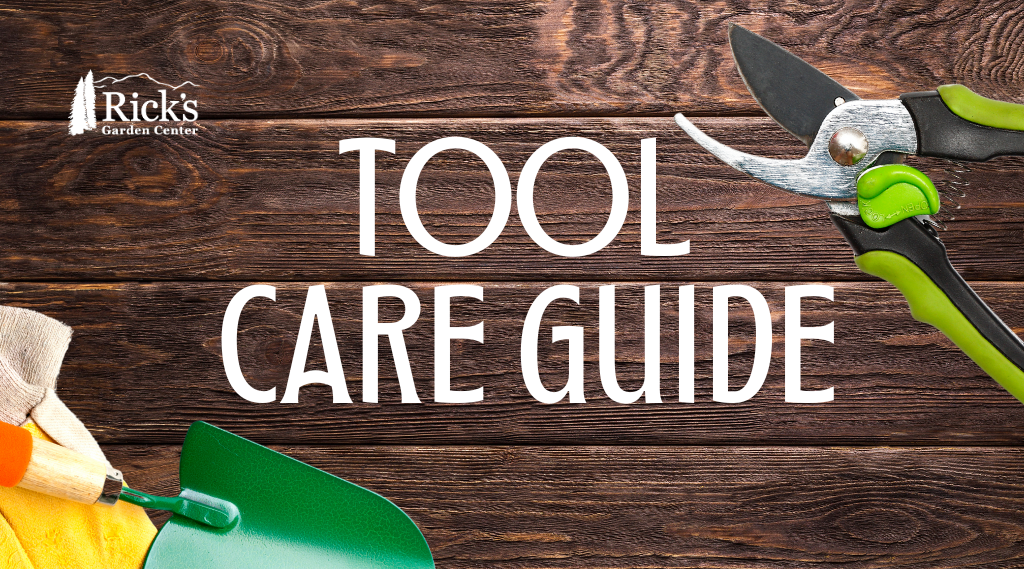
Protecting Our Watershed While Gardening & Landscaping
By Katherine Placzek
Every item that we use in our green spaces– fertilizers, pesticides, sprays, powders and granules, etc. all make their way into the water, after it rains or when we water our plants. This means a myriad of compounds, organic and synthetic, are making their way in our or someone’s drinking water. Yes, most of our drinking water is filtered, but this also impacts lakes, streams, aquifers, wells, and other sources of water that can be a habitat for other living organisms, big and small. While this may feel overwhelming initially, we have the power to make little meaningful changes in the way we manage our landscapes.
Lawn and Garden Fertilization
Three things make a difference here. Quantity, quality and timing:
Quantity: When you use fertilizer, always use the instructed amount of fertilizer or a diluted/ lesser amount. This ensures that your plants can take up the applied fertilizer and that excess is not making its way into our waterways. Excess fertilization can stress plants and negatively impact water quality. Over fertilizer use through agriculture, golf course maintenance, and community landscaping have contributed to dead zones in waterways. A dead zone is where all aquatic life ceases to exist. First, expansive algae blooms occur that crowd out sunlight, which choke oxygen out of the environment, causing inhabitable levels for any life, plant or animal. While some dead zones do occur naturally, the second largest one in the world is in the Gulf of Mexico, where many of North America’s waterways meet. This dead zone is widely attributed to human causes.
Quality: When choosing a fertilizer, it is advisable to read the ingredients, similar to reading food labels. If you cannot recognize an ingredient, know it is likely synthetic. Not all things that are human made are bad, but do your research. You may decide that you do not want some of these ingredients in your garage, home, yard, and local ecosystem. This is why Rick’s is proud to continue to carry our Organic Lawn and Garden fertilizers. Both of these are gentle fertilizers, with low nitrogen levels, and contain ingredients such as chicken manure, bone meal and blood meal.
Timing: Never fertilize before a severe rainstorm where run-off can take the majority of your fertilizer downstream. This is also cost prohibitive. If you plan on putting fertilizer down before predicted moisture, consider prior to a snowfall, where the melting snow can bring the fertilizer into the ground gently. Also read the instructions. Many fertilizers recommend a fertilizing schedule. Follow this, or see if you can stretch the schedule out further, to reduce the amount of fertilizer that you have to buy and apply throughout the year. Never fertilize more than what is recommended, this can stress the plant, and excess product will be absorbed into the waterways.
Pesticide Use
Pesticides include insecticides, herbicides, and fungicides. Similar to fertilizing, follow the same wisdom regarding quantity, quality and timing. We have said it before, but just to remind you: “While pesticides are convenient and sometimes necessary especially when mitigating invasive plant species, pesticides negatively impact pollinator numbers…. It is important to remember that while applying control products at night can reduce pesticide exposure to several pollinators/ beneficial species, this does not protect nocturnal pollinators such as moths and bats. When we use pesticides there is no current method that does not negatively affect pollinators or their second tier predators, who are further up the food chain (Excerpt from our March 2024 newsletter).” All of these pesticides reach water sources that are drinking water for pollinators and larger organisms: birds, fish, fox, deer, etc. Many of the chemicals used in popular pesticides, including glyphosate do not break down with water. This means the problem is washed downstream, but never away, and can exist in our waterways indefinitely. Manual removal of weeds is no fun- we all know this. When we choose conventional pesticides, we give up clean water. Limiting the amount of pesticides we use in our yards is one step to keeping our watershed less polluted.
General Maintenance
When you mow your lawn, consider mulching the cut grass instead of bagging it unless you use the cut grass in your compost. Mulched grass that has been chopped by the mower multiple times and is spread evenly over the lawn acts as a wonderful additive of organic material to the soil. This method improves water retention, and overall soil health, decreasing your need for fertilizer. If you mulch the cut grass, but leave large clumps of thatch, this can burn your grass and be swept away into a waterway. This process can act similarly to over fertilization, causing algae blooms downstream. Use the same logic with fall leaves. Mulch leaf litter and either use it on your lawn or in your garden, to add nutrition to the soil. Avoid abandoning leaves in gutters, and storm drains, as it increases excess nitrogen in the watershed. In the winter, make sure you are using a low saline and non-toxic ice melt as well. Water guardianship takes place in all four seasons!
Plant Selection
Finally, the fun stuff! Select plants and grasses for your landscape that are resilient to the Rocky Mountain circumstances. When we do this, we automatically reduce the need for mowing, fertilizing and the use of pesticides. Native plants especially, have been living here in the Colorado landscape much longer than any human lifespan. They have been taking care of themselves without any of our human care measures, such as fertilization, and will continue to do so into the future. I believe that by choosing to plant native plants in a landscape, you are actually simplifying your overall workload in the yard. You will fertilize less, you will use pesticides less, and regarding grass, you will mow less. That means more money in your pocket and more sitting on the back porch, sipping on a cold beverage. Cheers!

Blossoms on Your Plate
Are you ready to elevate your gardening game to a whole new level of deliciousness? Well, we’re about to dive into the vibrant world of edible flowers that will not only make your garden pop but also your plate! Many of them are easy to grow, forgiving of rookie mistakes, and will reward you with an explosion of colors and flavors.
Nasturtiums (Tropaeolum majus): These deep burgundy to buttery yellow blooms have a peppery kick, perfect as a spicy twist to salads, tacos, and avocado toasts. Bonus: They’re easy to grow, thriving in poor soil and other neglect. These flowers are high in vitamin C. The entire plant is edible- so try out the lily pad-like leaves also! Deer resistant.
Calendula (Calendula officinalis): Often called “poor man’s saffron,” the golden petals of calendula add a subtle saffron flavor to rice dishes and soups. They’re sun lovers and can tough it out in the Rocky Mountain soil. This flower is also known for its skin-healing properties, consider making a toner with calendula flowers. Deer are typically not a fan of these flowers.
Pansies (Viola tricolor): These adorable flowers come in an array of colors and have a slightly sweet, grassy taste. Scatter them over desserts after dipping them in water and then sugar for a delicate but sweet touch. Or freeze them in ice cubes for fancy drinks. Pansies are cold-hardy and can withstand our unpredictable mountain weather. We had a pot of pansies survive the entire winter, even when temperatures dipped below 20 degrees!
Lavender (Lavandula angustifolia): Known for its calming aroma, lavender adds a delicate floral flavor to desserts, teas, and even cocktails. It thrives in well-drained soil, making it a great match for rocky gardens. We have several varieties that will survive year-round in our nursery area. Look for varieties such as Munstead, Hidot Blue, and Phenomenal. Due to the fragrance of these flowers, deer typically leave them alone.
Rose (Rosa spp.): Beyond being a symbol of romance, roses can be used in various culinary creations. Make tea with their dried petals, infuse honey with their fragrance, or toss the petals into desserts. The rose hips that are produced in the fall are also edible and high in vitamin C. You can make tea from the rosehips as well. We have several varieties of roses, some more bred for their blooms, others are cultivated to be hardy for our mountainous climate.
Borage (Borago officinalis): With its brilliant blue flowers, borage adds a refreshing cucumber taste to salads, drinks, and desserts. The best part? Borage is a self-seeding annual, making it a low-maintenance addition to your garden. The pollinators will also feast on these blooms! Deer typically avoid this plant.
Chamomile (Matricaria chamomilla): Beyond being a bedtime tea, chamomile flowers can be used in salads or infused into syrups that go well in cocktails, over ice cream, or on pancakes. These sun-loving plants will thrive in our bright sun. Deer tend to avoid this plant due to its fragrance.
Dianthus (Dianthus spp.): Also known as pinks, or sometimes recognized as carnations, these flowers have a mild clove-like flavor. Add them to fruit salads, and desserts, or dry them and add them to various spice blends (za’atar, is a great example). Dianthus are hardy perennials, returning year after year. They are also deer-resistant.
Hibiscus (Hibiscus rosa-sinensis): Hibiscus flowers make a delightful and tropical addition to beverages, jams, and desserts. We carry gorgeous hardy hibiscus that will winter as a perennial shrub. Hibiscus also has high levels of vitamin C and is an excellent herb for overall health.
Daylilies (Hemerocallis spp.): Despite their fleeting beauty, daylilies are edible and offer a slightly sweet flavor. Stuff the blossoms with a soft cheese, or add them to stir-fries. Do your research on whether you have a daylily, before digging into a meal. Not all species of lilies are edible. These hardy perennials are a reliable choice in our climate.
Elderflower (Sambucus nigra): Fragrant elderflowers can be used to make refreshing beverages like elderflower cordial or add a subtle floral note to desserts. Elderflowers come from elderberry bushes, so you will also be able to eat elderberries if the birds don’t beat you to it! These shrubs are well-suited for the mountain environment, making them a great choice for your garden.
So, whether you’re a seasoned horticulturist or a budding green thumb, dive into the world of edible flowers and turn your garden into a culinary masterpiece. After all, why just stop and smell the roses when you can toss them in a dish too? Happy gardening and bon appétit!
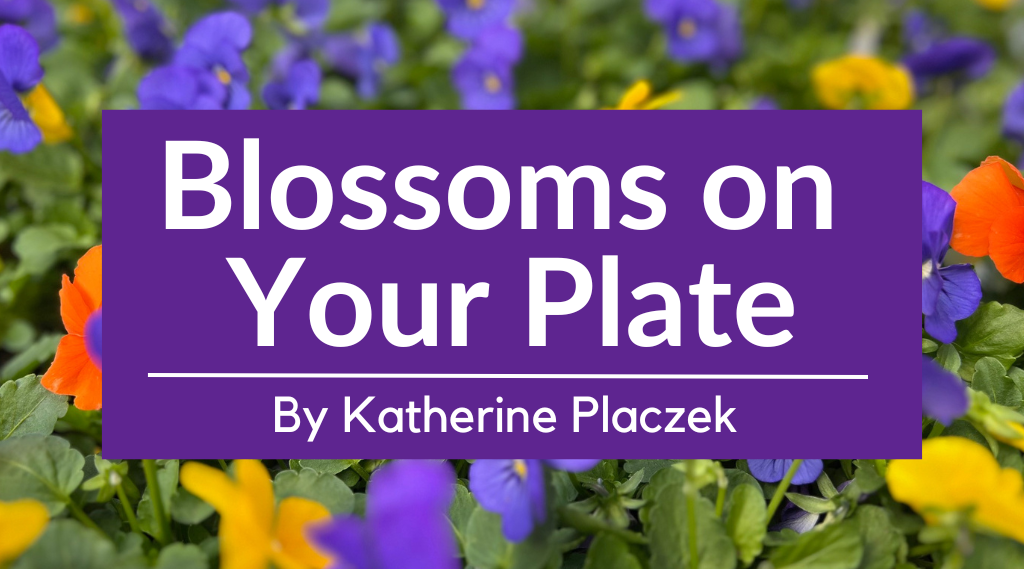
Embracing Nature’s Way: Integrated Pest Management
Integrated Pest Management is like the Gandalf of gardening – a wise, all-encompassing strategy that balances the forces of nature to keep your greenery flourishing. At its core, IPM is a holistic approach that combines biological, cultural, and physical/ mechanical control methods to manage pests and diseases. Instead of reaching for a pesticide or other control products, we tap into the power of Mother Nature herself to maintain a thriving and balanced ecosystem.
Some of our IPM practices include:
- Biological: Releasing ladybugs or other beneficial insects inside our greenhouses, or hoop houses to feast on those insects that are a bother; aphids, scale, mealy bugs, leafhoppers, etc. We also let spiders do their good work eating larger insects, like grasshoppers.
- Cultural: Reducing watering if fungal or pest problems crop up.
- Mechanical: Manually removing bugs from plants by hand or with water (aphids, mealy bugs, scale, potato bugs, etc)
While we lean into biological, cultural, or mechanical solutions, the last part of IPM is responsibly utilizing chemical products to rid of pests. This means we use more natural controls, such as Neem oil or Spinosad Soap, before other products. It is also important for us to factor in when pollinators or other beneficial insects may be around. So we try to spray when these individuals are not active. We also follow recommended application methods to avoid pollution of our environment or incur undue costs.
Why does Rick’s Garden Center Choose IPM Over Pesticides?
Environmental Harmony:
- Pesticides can disrupt your garden’s delicate ecosystem – effective, but with unintended consequences. IPM, on the other hand, dances with nature rather than against it. By embracing natural predators, beneficial insects, and environmentally friendly practices, we create a harmonious balance that keeps the pests at bay without harming the environment. By mostly avoiding synthetic chemicals, we reduce the environmental impact and create a garden that’s both beautiful and a haven for beneficial insects and wildlife.
Economic Sense:
- Let’s face it – pesticides can burn a hole in our pockets. IPM, however, is cost-effective in the long run. By relying on natural solutions, we reduce the need for constant reapplication of expensive chemicals, improving our bottom line.
Happy and Healthy Plants:
- Picture this: a garden where plants are not only surviving but thriving. That’s the magic of IPM. By addressing the root causes of pest problems and fostering a healthy soil environment, we ensure that your green companions are resilient and ready to face whatever life throws their way.
Community Connection:
- We believe in building a community that shares our love for the earth. By choosing IPM, we invite our customers to join us in creating a garden that is a testament to the power of working hand in hand with nature.
At Rick’s Garden Center, IPM isn’t just a gardening strategy – it’s a philosophy. It is about embracing the rhythms of nature and inviting others to join us toward a more sustainable future. So, next time you visit, know that you are not just buying plants; you are becoming a part of our eco-minded family.
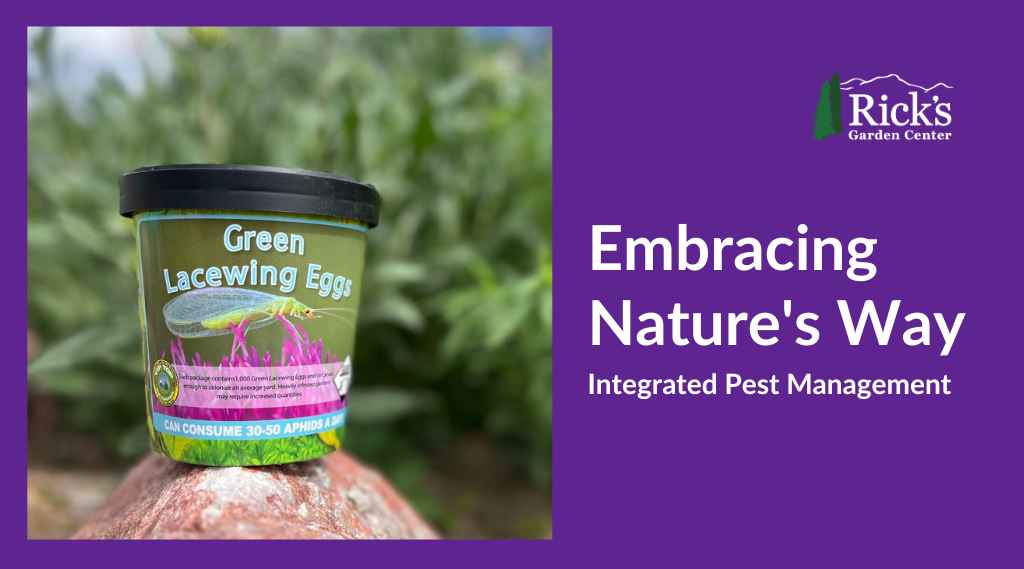
The Gothic Vegetable Garden
By Katherine Placzek
Black & purple vegetables are not only for someone who is looking for a fun or Gothic vibe in their garden. Purple-ish fruits and vegetables have higher antioxidants, which play an important role in protecting your cells against heart disease, cancer, and other diseases. So it is healthy for you to plant and eat these dark maroon beauties!
All of these vegetables are carried by us as seeds through the Botanical Interests or Lake Valley Seed brands (both CO businesses). There is a wide array of purple/ black vegetables so feel free to go down the rabbit hole and create the dark and mysterious garden of your dreams! Note that various seeds may be out of stock throughout the season.
Amaranth
Burgundy: These plants offer beauty and sustenance! The plants can get tall and have elegant and eye-catching burgundy plumes that can be used in flower arrangements. The seeds were a major crop of the Aztecs, and are very high in protein and other nutrients. Cook the beige seeds like rice. Young leaves are also edible- use them in salads or steamed. The birds will also enjoy the seeds!
Basil
Cardinal: Cardinal’s’ deep crimson blooms allow this basil variety to be utilized beyond its culinary qualities! Use it as a surprising accent in a mixed container, or use it as a cut flower! The fragrance is lovely. With its strong scent, a little goes a long way in the kitchen. A wonderful dual-purpose herb.
Purple Petra: A deep purple, this basil adds vibrant color to any dish! A more mild basil- great for those who just want the essence of basil in their cooking. ‘Purple Petra’ can be used to make an elegant pink-tinted vinegar also! Use it as a companion plant to your nightshade veggies or as a statement plant in an herbal ensemble or annual flower container.
Purple Opal: Opal Basil has eye-catching purple leaves, and will bloom during the summer with light pink flowers. Feel free to fall in love with this variety! Grow it just for its rich beauty or for its culinary uses. Highly flavorful, this basil variety has flavor notes of cinnamon, anise, mint, and clove!
Siam Queen Thai: This beautiful basil has a complex sweet and spicy flavor with a hint of anise. Broadly used in Thai and Vietnamese dishes- it is versatile! It is easy to grow and highly ornamental with its dark amethyst blooms. Flower farms also grow Thai basil, for cut bouquets. Include it in your garden flower bunch and enjoy the unique fragrance. Bees also love this stuff!
Sweet Thai: Thai basil is of course a popular herb in many Southeast Asian cuisines, and is most regularly highlighted in a warm bowl of Vietnamese pho. This variety holds its flavor and texture through cooking more than other basils. Lovely in salads or when eaten fresh. Sweet Thai’s dark purple flowers and intoxicating scent allow it to double as an excellent addition to the flower garden. Produces well in containers also.
Beans
Royal Burgundy (Bush): Royal Burgundy has yummy purple pods that are easy to spot among green leaves. A wonderful variety to grow in cool weather and is unlikely to be challenged by bean beetles. A good container variety, as well as disease-resistant.
Trionfo Violetto (Pole): Trionfo Violetto’ translates to “purple triumph.” This Italian heirloom will win your heart, with its crisp and flavorful purple pods. While highly ornamental the plants are also highly prolific! The plants climb 6’–8′, and have prolific light amethyst flowers that bloom against green leaves that sport purple veins and stems. Similar to other purple beans, the pods magically turn green when they are cooked!
Beets
Bulls Blood: Plant one row of this beet variety for the beautiful greens, and another for the flavorful roots! ‘Bull’s Blood’ is valued for its tender, sweet, and deep red– almost plum foliage. Originally selected from a French heirloom for the darkest colored leaves, the 16″ “greens” are rich in nutrients! The roots are delicious as well, especially so, when harvested small. Use in succession planting as multiple crops are possible throughout a season.
Broccoli
Burgundy: This variety of broccoli is considered a “sprouting broccoli” since it produces one small main head, but then produces generous side shoots. Purple broccolis tend to be tender, flavorful, and full of antioxidants! ‘Burgundy’; is tolerant of a wider range of temperatures, which allows a longer harvest period. Some gardeners prefer to pinch the main floret off early on, to encourage more abundant side shoots. Also resistant to the disease, Fusarium yellows.
Cabbage
Red Acre: Jazz up cole slaw or any stir-fry with this gorgeous, deep-fuchsia cabbage! This variety has a very fresh and sweet flavor. Solid heads form early and grow on compact plants making ‘Red Acre’ an ideal choice for urban gardeners who may have limited space. Resistant to splitting as well as cabbage yellows disease. The heads store very well, in the refrigerator or a root cellar. A variety you must try!
Carrots
Cosmic Purple Carrots: While various colored carrots seem to be the new fad, they have been around for centuries. In fact, the purple carrot has been around for at least 1,000 years! While previously unpopular compared to orange carrots, purple carrots have been rediscovered, and rightfully so! Besides being high in vitamin A, purple carrots contain anthocyanins (an antioxidant) that are common in blueberries. Kids will love them!
Eggplants
Black Beauty: A beautiful nearly black vegetable with lovely, lavender blossoms pretty enough to grow in the flower garden! ‘Black Beauty’ has set the standard since 1902 for large and high-quality fruit. When harvested at its peak, the skin is tender, so no need to peel it; making it perfect for eggplant parmesan, ratatouille, and grilling!
Finger Fruit Purple: Grow fast-producing clusters of beautiful eggplants on your patio or a sunny corner of your vegetable plot! These 4-6″ fruits contain few seeds and have thin, tender skin—perfect for stir-fries and roasting. A plethora of royal purple fruits on just 22-38″ tall plants make this variety a perfect fit for containers and small gardens.
Jewel Amethyst: ‘Jewel Amethyst’ is perfect for containers, since it has a tidy habit. You will also notice its growing pattern makes harvesting a joy! The oval, purple fruits are best harvested when about 3”–4 ½” long, to stay tender. Harvest regularly from this variety to keep eggplant producing throughout the season.
Long Purple: This long, slender variety, is not usually found in grocery stores, and is a treat! Sometimes called ‘Italian Long Purple’, this prolific heirloom will bring beautiful ruby-purple color to the garden and savory goodness to the table. Enjoy in a wide variety of dishes!
Kohlrabi
Early Purple Vienna: Early Purple Vienna kohlrabi is an easy-to-grow cool weather crop that forms a distinctive dusty lilac bulb with pale flesh above ground. A beautiful plant! Peel its crunchy bulb and enjoy it raw or cooked. Leaves are also edible- eat similarly to collards, or other steamed greens. Kohlrabi is high in fiber, making it an excellent veggie for overall gut health. Kohlrabi is also high in isothiocyanates and glucosinolates, which are powerful antioxidants, thought to lower the risk of certain cancers, heart disease, and inflammation. Keeps well in the fridge.
Lettuces/ Greens
Brentwood Lettuce: This variety produces pretty burgundy lettuce leaves making for some beautiful salads! The heads produce high yields in compact spaces, and their bolt resistance allows for a long harvest. Also resistant to downy mildew, lettuce leaf aphid, and Fusarium wilt.
Dazzling Blue Kale: You will be mesmerized by the beautiful colors of this extra-cold-hardy kale. It is even more cold-tolerant than other lacinato types. The purple midrib pops against the blue-green leaves, some of which may take on more purple hues in the cool temperatures of fall. Lacinato kale is ideal for kale salads. Pick tender, baby greens for fresh salads, chips, or sauteing, in just 30 days!
Marvel of Four Seasons: Tasty and attractive, this 1800s French heirloom is also known as Merveille de Quatre Saisons. The variety has sweet and tender leaves that are chartreuse green at the base, turning to a beautiful cranberry-red, and forming a crinkly rosette! Gorgeous! Rosettes are 8″–12″ in diameter and good for large containers.
Red Russian Kale: Typically, kale gets sweeter after the first fall frost. ‘Red Russian’, on the other hand, is sweet and tender all the time. The lavender veins are part of what makes ‘Red Russian’ as attractive as it is delicious. Harvest baby greens in just 21 days!
Truchas Mini Romaine: This deep-merlot, mini-romaine is a game-changer for salads! ‘Truchas’ is compact and easy to grow in small spaces. It also creates gorgeous contrasts with green lettuce. Uniform leaves stay upright in the garden and make for easy plant cleanup. Has disease resistance to downy mildew, lettuce die-back, and lettuce mosaic virus.
Nasturtium
Black Velvet: These edible beauties add glamorous, ruby-black color to your salads and cheese plates! All parts of the flower (leaves, seeds, stems and flowers) are edible! Garnish tacos, avocado toasts, and pasta dishes with these beauties! Excellent as a companion plant to your tomatoes, and they repel several pests. Gorgeous in containers as well.
Tom Thumb Black Velvet: Tom Thumb features velvety, nearly black flowers with contrasting bright green foliage! Compact plants make this an outstanding choice for the border and containers. All parts of the flower (Leaves, seeds, stems and flowers) are edible! Add flowers to charcuterie boards, gazpachos, strewn on roasted root veggies, or create vinegar from them, for various culinary experiences!
Okra
Red Burgundy: Whether you eat okra or not, this plant is worth growing, just for the beauty of it! The pods are deep crimson edging toward maroon and are preceded by gorgeous yellow flowers that the bees love. This is the most productive red variety and will produce tender, 6″-long pods that are delicious in soup, gumbo, and stew, or deep-fried.
Shiso
Green and Red Shiso Perilla: An absolute must for herb gardens! Also called Japanese basil or the beefsteak plant, shiso’s incredible flavor can be described as a combination of cinnamon, mint, and clove with notes of cumin. A beautiful, heat- and drought-tolerant bedding plant that attracts pollinators, and is excellent for containers. This packet provides 75% green shiso and 25% red (shows up as a deep mulberry color).
Snap Pea
Sugar Magnolia: Wow, a purple snap pea that is tender and delicious! Enjoy the pretty purple blooms first, then the purple pea pods. Eat them without shelling, dipped in hummus, in a salad, or in stir-fries! Long hypertendrils (vigorous, multi-branching tendrils) support the 6′-7′ vining plants. This growing pattern creates an airy structure that helps prevent mildew. Some of these open-pollinated peas may be flecked with green, or be fully green.
Tomatillo
Purple: A purple tomatillo! Not only delicious but alluring also. The purple fruits are much sweeter than the green types and rich in antioxidants. Let the fruit remain on the plant as long as possible until the papery husks split for the best flavor and color. Tomatillos grow best in conditions similar to tomatoes (because they are related) but will handle a lot more heat. Tomatillos require cross-pollination so plant at least two plants in your garden to ensure good fruit production
Tomatoes
Black Krim: This Russian pole heirloom originated in Krymsk on the Black Sea in Russia. Baseball-sized fruits weigh 10–12 ounces and have dark reddish-brown flesh filled with a rich, slightly savory flavor. Fruit sets well in heat and is a reliable “black” tomato, producing even under adverse conditions from summer to fall. Make sure to stake or cage, as the plants can reach 6′ or more!
Cherokee Purple: Cherokee Purple’ is said to have been given to a Tennessee family by the Cherokees over 100 years ago. This dark maroon tomato has just the right balance of sweetness and even a hint of smoke, making it a winner in taste competitions. From summer into fall, you will harvest lots of 10–12 oz. tomatoes from this well-regarded heirloom variety. Make sure to stake or cage, as the plants can reach 6′ or more!
Chocolate Cherry: Chocolate Cherry tomatoes—Yum! These 1″ purplish-red, delicious tomatoes are great for snacking on and add a bit of sweetness to salads and pasta. The prolific vines bear seemingly endless trusses with 6–8 ounce fruits that will bring you back for harvest after harvest. Fruit is crack-resistant! Make sure to stake or cage.
Watermelon
Sugar Baby: The taste of summer? Watermelon! As the name suggests, ‘Sugar Baby’ is sweet, sweet, sweet! It is also small enough to easily fit in the refrigerator. This plant produces a bountiful crop of 8–10 pound deep dark emerald green orbs that have juicy red flesh.
Zucchini
Black Beauty: Black Beauty is an early maturing zucchini-type squash that features delicious deep black to green fruits with pale flesh. A very easy-to-grow bush variety that is highly productive all summer long. Enjoy grilled, sauteed, fresh, in soups, or zucchini bread!
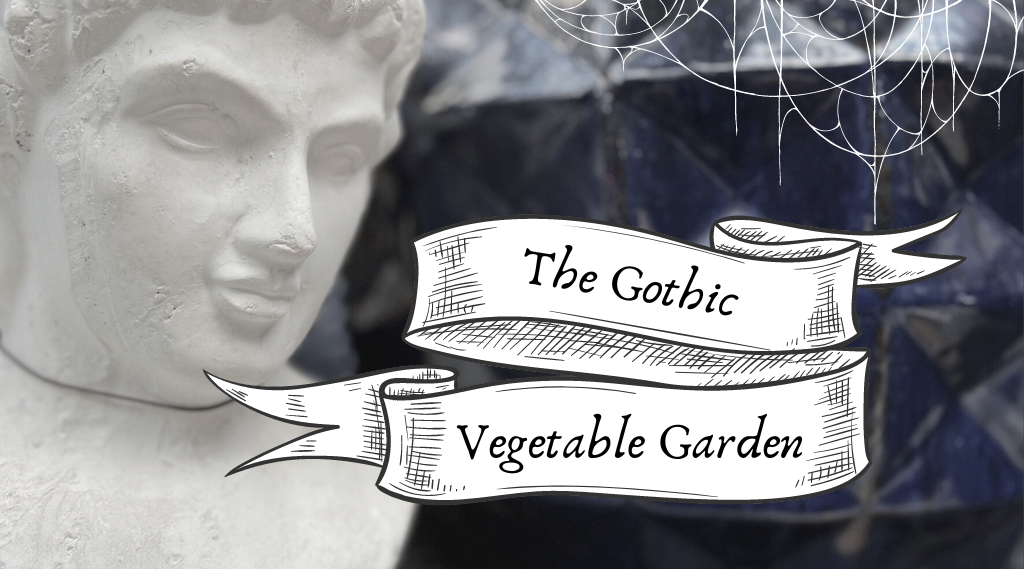
Bare Root Fruit Trees
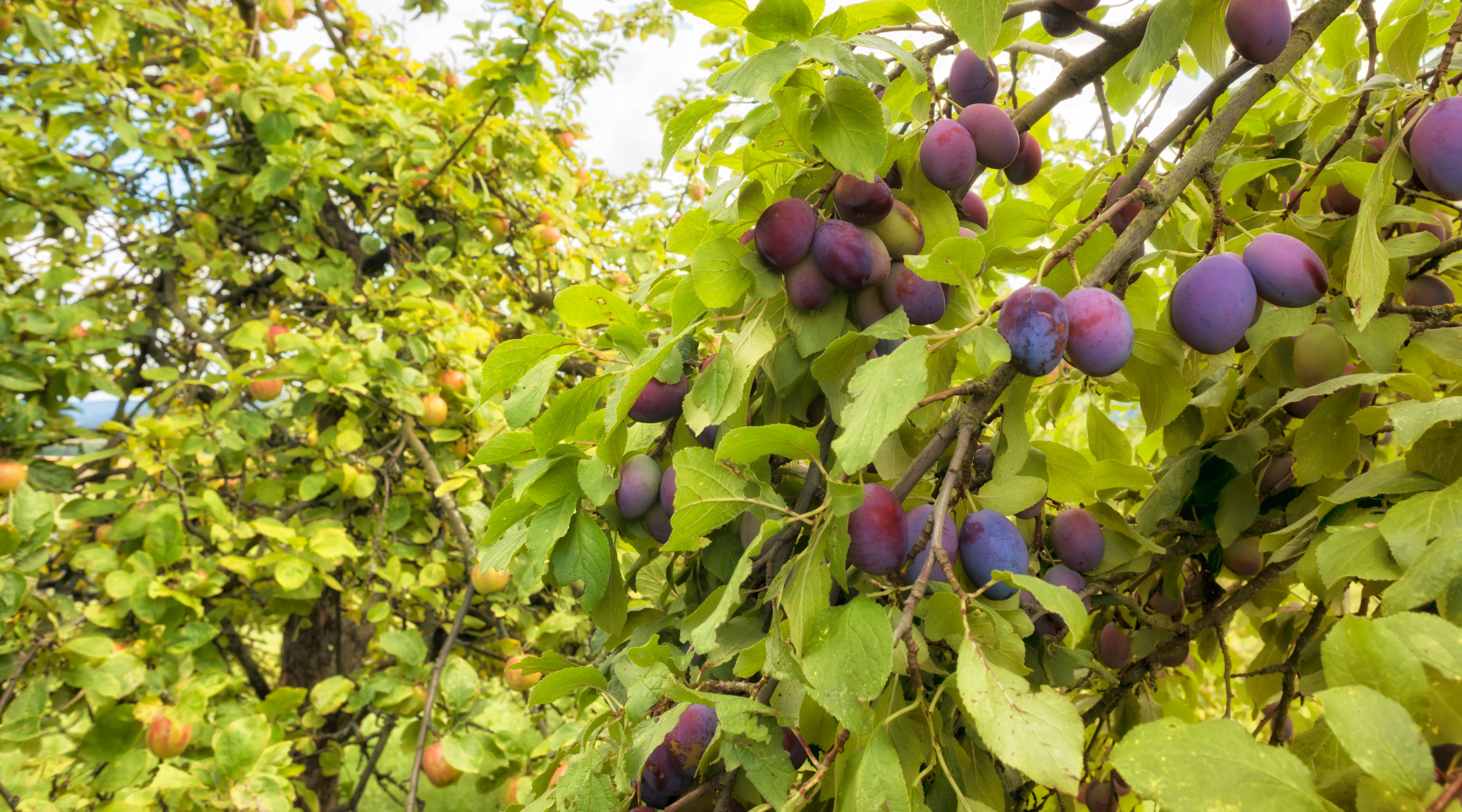
What are bare root trees?
Bare root trees are harvested from their growing beds in the late fall, and the soil is removed from their roots. They are kept in cold storage over the winter, and planted before they break dormancy in the spring.
What are the advantages of planting bare root trees?
Improved Tree Health
Bare root trees are not grown in a container. This eliminates the industry-wide problems of circling and girdling roots that develop in container-grown stock, a major threat to even healthy-looking plants. Also, since bare root trees are planted early in the spring before they leaf out, the trees get a head start on developing strong root systems in the native soil before they start producing leaves, flowers, and fruit.
Light Weight & Reduced Environmental Impact
Bare root trees are much lighter when shipped. This saves on freight and fuel and makes them easier to maneuver while planting.
More Cost Effective
Shipping bare root trees is much less expensive, and that savings is passed directly to the customer. Our trees will be comparable in size to a #5 container tree, but for half the price! (All trees will be a minimum of 5/8th inch caliper.)
We are excited to offer bare root fruit trees at Rick’s this spring! We are working hard to bring you the best fruit trees possible.
Excellent Quality
The bare root fruit trees we are selling will be of superior quality! We chose to source these trees specifically from growers who supply professional orchardists. Van Well Nursery is based in Washington state and works with several orchards in the Palisade, Colorado area. They have an excellent reputation among professional growers, and we’re excited to offer that level of quality in Colorado Springs! We have consulted with Van Well to bring you the best in bare root fruit trees for our local climate.
Exceptional Rootstock
Since their seed is not true to type, fruit trees are produced from cuttings. Many species of apples, pears, and plums do not root easily from cuttings, so they are grafted onto rootstock grown specifically for this purpose, a practice dating back over 2,000 years.
When purchasing any fruit tree, it is important to inquire about the quality of the rootstock. For our bare root trees, all apples are grafted onto EMLA 7 rootstock. This rootstock is semi-dwarfing, meaning each variety will grow about 50-60% smaller than typical, which is perfect for backyard orchards. This rootstock was chosen for its cold hardiness and extreme resistance to fireblight. The plums are grafted onto a peach seedling rootstock.
Interesting Varieties
This year, Rick’s will have eight kinds of apples and two kinds of plums to choose from. We will have heritage apples like Macoun and Yellow Newton, and some new arrivals like Ambrosia and Gale Gala. We even have an apple variety that’s used for cider, Yarlington Mill, which arose from a chance seedling discovered in 1898! The plum varieties are both European plums and are very cold hardy.
It should be noted that all apples need another apple (or fruit-bearing crabapple) of a different variety to cross-pollinate. Both types of plums that we carry are semi self-fruitful, but they will bear a heavier crop with a different plum cultivar nearby to cross-pollinate. The two plum varieties we will be carrying will cross-pollinate with each other very nicely. For fruit trees to cross-pollinate, they should be planted within 100 feet of each other.

Cost and Availability
Each bare root tree will be $39.99 and will be sold on a first come, first served basis.
The trees will be arriving in early March, weather permitting. We will continue to sell the bare root trees until they start to break bud, most likely in early April.
If you would like to be notified when the bare root trees become available, please email us at info@ricksgarden.com or call the store at (719) 632-8491 to be put on our notification list.
Timing and Handling
Timing is important when purchasing and planting bare root fruit trees. Bare root trees can only be planted in the early spring. Bare root trees that are planted after they leaf out have a much lower survival rate.
Proper handling is crucial for bare root stock. Roots should never be allowed to dry out – even five minutes of sun exposure on a warm day can do life-threatening damage to the tree. When you purchase a bare root tree from Rick’s, you will be provided with a burlap sack and wet mulch (or other means) to protect the roots during transportation.
The tree should be planted as soon as you get home from the nursery. If you will not be able to plant the tree immediately, please talk to our nursery staff so they can advise you on proper storage procedures.
Planting
Planting bare root trees is very similar to planting trees that have been grown in containers. The most important thing is to not plant too deep; you should have a structural root within the first one to two inches of soil. Amend soil to a maximum ratio of one part compost to four parts native soil. Cover the planting area with three inches of mulch, taking care to not contact the trunk. Staking may be necessary depending on root spread, soil type, and wind exposure.
Protection
Young trees that are small in diameter are the perfect size for deer to rub their antlers on. If deer graze in your neighborhood, cage trees immediately after planting. Trees left unprotected for even one night can be terminally damaged by deer.
For additional tree planting resources, please visit:
Tree & Shrub Planting Guide by Rick’s Garden Center:
The Science of Planting Trees by CSU Extension: https://cmg.extension.colostate.edu/Gardennotes/633.pdf
